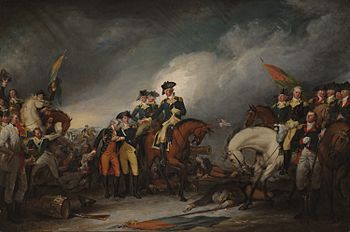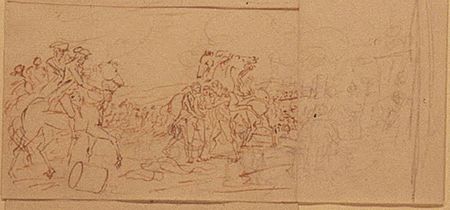The Capture of the Hessians at Trenton, December 26, 1776 facts for kids
Quick facts for kids The Capture of the Hessians at Trenton, December 26, 1776 |
|
|---|---|
 |
|
| Artist | John Trumbull |
| Year | 1786–1828 |
| Medium | oil on canvas |
| Dimensions | 51.1 cm × 76.2 cm (20.125 in × 30 in) |
| Location | Yale University Art Gallery, New Haven, Connecticut |
The Capture of the Hessians at Trenton, December 26, 1776 is a famous oil painting. It was created by the American artist John Trumbull. The painting shows an important moment from the American Revolutionary War. It highlights the capture of German soldiers, known as Hessians, during the Battle of Trenton. This event happened on December 26, 1776.
The main focus of the painting is General George Washington. He is shown helping the badly wounded Hessian Colonel Johann Gottlieb Rall. Almost 900 Hessian soldiers were captured in this battle. This painting is part of a series by Trumbull about the war. Other paintings in this series include the Declaration of Independence. You can see this painting at the Yale University Art Gallery in New Haven, Connecticut.
John Trumbull wanted to show General George Washington's kindness in this artwork. He wrote about it in 1835. Trumbull said Washington's actions were a great example of true heroism. He hoped all soldiers would learn to be kind to enemies who were hurt or captured.
Contents
Creating the Painting: A Look at Its History
John Trumbull himself was a soldier in the American Revolutionary War. He started serving in 1775. He even worked as an assistant to General Washington. Trumbull left the army in 1777. He began planning this painting in London in 1786. His early sketches showed Washington arriving to make sure Rall was treated with respect. Trumbull returned to New York in 1789. He continued working on the painting until it was finished in 1828. He even painted portraits of Washington to help him with the work.
What the Painting Shows: Key Figures and Moments
In the middle of the painting, you can see American General George Washington. He is focused on helping the seriously wounded Hessian Colonel Johann Gottlieb Rall. Rall is being supported by American Major William Stephens Smith. Washington tells Smith to get the best doctors to help Rall. He wants to save Rall's life if possible. During the real battle, Rall was shot twice. He was carried to his headquarters and died later that night.
Behind Washington, on horses, are his assistants. These are Colonel Robert H. Harrison and Captain Tench Tilghman.
To the left of Rall, American Lieutenant James Monroe is also wounded. Dr. John Riker is helping him. Dr. Riker saved Monroe's life by quickly stopping heavy bleeding. On the far left, dressed in white, is American Colonel Josiah Parker. He had the honor of receiving Rall's sword when the Hessians surrendered. He is the only one holding a sword in the painting. Next to him are Colonels Edward Wigglesworth and William Shepard.
On the right side of the painting, you can see American Major General Nathanael Greene. He is on a light-colored horse, facing Washington. Behind Greene are other American Generals. These include John Sullivan, Henry Knox, Philemon Dickinson, John Glover, and George Weedon. Standing to the right of Greene is Captain William Washington. He was wounded in his hand during the battle.
In the front of the painting, a fallen Hessian flag is shown. General Washington later received one of these flags as a war trophy.
Other Versions of This Artwork
There is a larger version of this painting. It measures about 72 inches by 108 inches. This bigger painting was finished in 1831. It is now owned by the Wadsworth Atheneum in Hartford, Connecticut.
Images for kids




